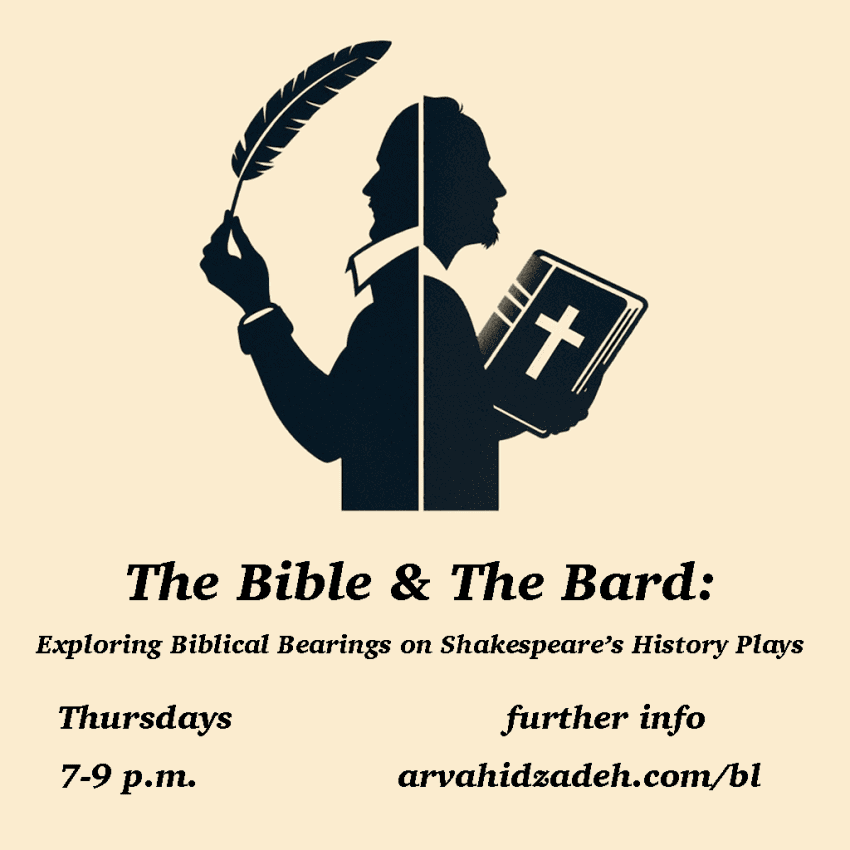Course Overview
This course undertakes a thorough examination of the complex interrelations between Shakespeare’s history plays and Biblical texts. We shall explore how Biblical themes, references, and symbols are seamlessly integrated into Shakespeare’s depiction of history, politics, and morality, revealing the subtle and profound ways in which these sacred elements inform and enrich his dramatic portrayal of the past.
Session 1: Introduction to Shakespeare’s History Plays and Biblical Contexts
-Objective: Establish the foundational context for understanding the interaction between Shakespeare’s history plays and Biblical references.
– Topics Covered:
– Overview of Shakespeare’s history plays (e.g., Richard III, Henry IV, Henry VIII)
– Introduction to key Biblical narratives and themes
– Discussion on Shakespeare’s use of the Bible as a literary and thematic resource
– Comparative analysis of how the Bible and historical events are interlinked in the plays
Session 2: The Bible as a Source of Symbolism and Imagery
– Objective: Examine how Shakespeare utilises Biblical symbolism and imagery in his history plays.
– Topics Covered:
– Analysis of Biblical symbols and imagery found in Shakespeare’s texts
– Case studies of specific symbols (e.g., crowns, visions) and their Biblical origins
– Discussion on the impact of these symbols on character development and narrative
– Exploration of how Shakespeare integrates Biblical imagery to enhance thematic depth
Session 3: Theological and Moral Underpinnings in Shakespeare’s History Plays
– Objective: Explore the theological and moral frameworks drawn from the Bible and their reflection in Shakespeare’s portrayal of historical events.
– Topics Covered:
– Examination of Biblical moral lessons and theological concepts (e.g., divine justice, humility)
– Analysis of Shakespeare’s treatment of these concepts in his historical dramas
– Comparative discussion of specific moral and ethical dilemmas in Shakespeare’s plays and their Biblical parallels
– Insights into Shakespeare’s theological motivations
Session 4: Biblical Archetypes and Their Resonance in Shakespeare’s Characters
– Objective: Analyse how Biblical archetypes and figures are reflected in Shakespeare’s historical characters.
– Topics Covered:
– Identification of key Biblical archetypes (e.g., the Just King, the Fallen Hero)
– Examination of Shakespearean characters that mirror these archetypes (e.g., Henry V, Richard III)
– Discussion on how these archetypal representations influence character dynamics and plot development
– Application of frameworks for understanding the interplay between Biblical and Shakespearean archetypes
Session 5: Divine Providence and Fate in Shakespeare’s Historical Narratives
– Objective: Investigate the themes of divine providence and fate in Shakespeare’s history plays and their Biblical origins.
– Topics Covered:
– Analysis of the concept of divine providence in Biblical texts (e.g., the Book of Job, Proverbs)
– Shakespeare’s depiction of fate and divine will in his historical plays
– Comparative analysis of scenes and characters reflecting these themes
– Discussion on how divine providence and fate are integrated into Shakespeare’s narratives
Session 6: Synthesis and Reflection: The Bible’s Influence on Shakespeare’s Historical Vision
– Objective: Synthesise insights from the course to evaluate the overall influence of Biblical references on Shakespeare’s depiction of history.
– Topics Covered:
– Recap of major themes, symbols, and archetypes discussed throughout the course
– Integrative analysis of how Biblical elements shape the portrayal of historical events and characters in Shakespeare’s plays
– Final discussion on the broader implications of Biblical influence on Shakespeare’s historical narratives
Note: The course will include close readings of Shakespearean texts and Biblical passages, along with discussions and critical analyses based on the themes outlined in the course overview.
